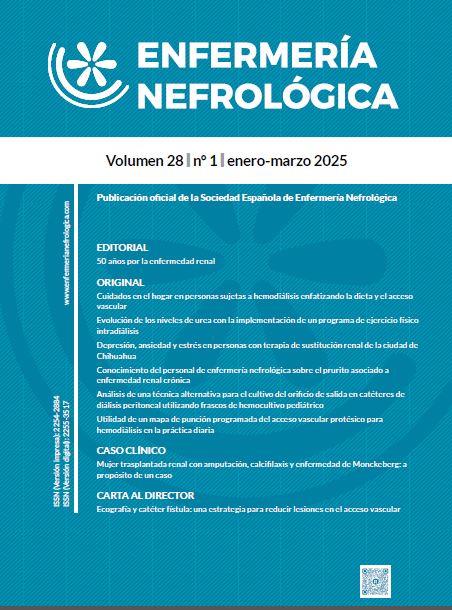Main Article Content
Abstract
The use of ultrasound has been shown to improve knowledge of vascular access, facilitating the choice of puncture sites and increasing confidence in difficult punctures. With the aging of the hemodialysis population, vascular deterioration complicates access to the native arteriovenous fistula, thus increasing the risk of complications such as hematomas, thrombosis, and stenosis. These difficulties can lead to the use of central venous catheters, increasing morbidity and mortality.
Conventional metal needles can damage the native arteriovenous fistula, reducing its longevity. As an alternative, the fistula catheter minimizes vascular damage by reducing the risk of extravasations and hematomas. This study compared both types of needles in 12 patients for 8 months (2 were excluded due to death, leaving 10 patients that were categorized into 2 groups). Ultrasounds were performed to evaluate vascular involvement.
Results showed that 80% of patients with conventional metal needles presented injuries, while only 40% of the fistula catheter group developed damage, which resolved during the study. No significant changes in native arteriovenous fistula flow were observed in either group.
Ultrasound monitoring allowed changes to puncture sites to
prevent long-term complications. It is concluded that the use of fistula catheters, along with ultrasound and trained personnel, can reduce complications and prolong the life of vascular access, avoiding unnecessary surgical procedures and improving the quality of hemodialysis treatment.
Keywords
Article Details
Copyright (c) 2025 Laia Reixach Aumatell, Hilda Fernandez Punset, Isabel Pérez García, Alícia Rey Miguel

This work is licensed under a Creative Commons Attribution-NonCommercial 4.0 International License.
Author copyright notice
© Authors grant the publisher the non-exclusive licence to publish the work and consent to its use and distribution under the Creative Commons Attribution - NonCommercial 4.0 International (CC BY-NC 4.0) licence. Read the licensing information and the legal text here. This must be expressly stated wherever necessary.
References
- Ibeas J, Roca-Tey R. Monitorización y vigilancia del acceso vascular. En: Guía española de acceso vascular para Hemodiálisis. Grupo Español Multidisciplinar de Acceso Vascular (GEMAV). Enferm Nefrol. 2018 [consultado 1 Mar 2025];21(Supl 1):S63-88. Disponible en: https://www.seden.org/files/documents/Elementos_1301_guia-seden-linkada18-09-34.pdf DOI: https://doi.org/10.4321/S2254-28842018000500001
- Cano M, López Castillo N. Punción de fístulas arteriovenosas en hemodiálisis: técnica convencional y punción ecoguiada. Rev Enferm Docente. [Internet]. 2023 [consultado 28 Oct 2024];118:13-6. Disponible en: https://www.sspa.juntadeandalucia.es/servicioandaluzdesalud/hospital/virgen-victoria/sites/default/files/2024-09/118-03-ES-Punci%C3%B3n%20de%20f%C3%ADstulas%20arteriovenosas%20en%20hemodi%C3%A1lisis.pdf
- Martínez Ocaña O, Rodríguez Estaire J, Ruiz Sanz B, Martín Navarro JA, Mérida Herrero E. Catéter-fístula: una nueva alternativa en la punción de accesos vasculares. Rev Soc Esp Enferm Nefrol [Internet]. 2010 [consultado 28 Oct 2024];13(2):105-11. Disponible en: http://scielo.isciii.es/scielo.php?script=sci_arttext&pid=S1139-13752010000200003&lng=es. DOI: https://doi.org/10.4321/S1139-13752010000200003
- Mallol Domínguez A, Carratalá Chacón J, Folch Morro MJ, Renau Ortells E, Cerrillo García V, Aicart Saura C, Bort Castelló J, Salvador Lengua C. Estudio comparativo de dos tipos de agujas para hemodiálisis: aguja clásica vs catéter Supercath. Enferm Nefrol. 2009;12(3):114-8. DOI: https://doi.org/10.4321/S1139-13752009000300003
- Moyano Franco MJ, Salgueira Lazo M, Roca-Tey R. Punción ecoguiada del acceso vascular para hemodiálisis. En: Lorenzo V, López Gómez JM, editores. Nefrología al día [Internet]. 2024 [consultado 4 Ene 2025]. Disponible en: https://nefrologiaaldia.org/es-articulo-puncion-ecoguiada-del-acceso-vascular-para-hemodialisis-592
References
Ibeas J, Roca-Tey R. Monitorización y vigilancia del acceso vascular. En: Guía española de acceso vascular para Hemodiálisis. Grupo Español Multidisciplinar de Acceso Vascular (GEMAV). Enferm Nefrol. 2018 [consultado 1 Mar 2025];21(Supl 1):S63-88. Disponible en: https://www.seden.org/files/documents/Elementos_1301_guia-seden-linkada18-09-34.pdf DOI: https://doi.org/10.4321/S2254-28842018000500001
Cano M, López Castillo N. Punción de fístulas arteriovenosas en hemodiálisis: técnica convencional y punción ecoguiada. Rev Enferm Docente. [Internet]. 2023 [consultado 28 Oct 2024];118:13-6. Disponible en: https://www.sspa.juntadeandalucia.es/servicioandaluzdesalud/hospital/virgen-victoria/sites/default/files/2024-09/118-03-ES-Punci%C3%B3n%20de%20f%C3%ADstulas%20arteriovenosas%20en%20hemodi%C3%A1lisis.pdf
Martínez Ocaña O, Rodríguez Estaire J, Ruiz Sanz B, Martín Navarro JA, Mérida Herrero E. Catéter-fístula: una nueva alternativa en la punción de accesos vasculares. Rev Soc Esp Enferm Nefrol [Internet]. 2010 [consultado 28 Oct 2024];13(2):105-11. Disponible en: http://scielo.isciii.es/scielo.php?script=sci_arttext&pid=S1139-13752010000200003&lng=es. DOI: https://doi.org/10.4321/S1139-13752010000200003
Mallol Domínguez A, Carratalá Chacón J, Folch Morro MJ, Renau Ortells E, Cerrillo García V, Aicart Saura C, Bort Castelló J, Salvador Lengua C. Estudio comparativo de dos tipos de agujas para hemodiálisis: aguja clásica vs catéter Supercath. Enferm Nefrol. 2009;12(3):114-8. DOI: https://doi.org/10.4321/S1139-13752009000300003
Moyano Franco MJ, Salgueira Lazo M, Roca-Tey R. Punción ecoguiada del acceso vascular para hemodiálisis. En: Lorenzo V, López Gómez JM, editores. Nefrología al día [Internet]. 2024 [consultado 4 Ene 2025]. Disponible en: https://nefrologiaaldia.org/es-articulo-puncion-ecoguiada-del-acceso-vascular-para-hemodialisis-592




